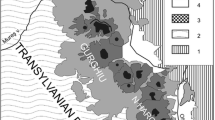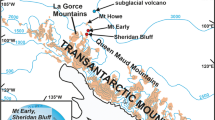Abstract.
A pronounced volcanic production maximum on the rift zones through Iceland coincided with rapid crustal rebound during and after glacier melting at the Pleistocene/Holocene boundary. At peak glaciation, ice thickness over central Iceland may have reached 1,500–2,000 m, causing 400–500-m depression of the crust. Rapid climatic improvement caused glacier melting and removal of the ice load within about 1,000 years. Low mantle viscosity resulted in rapid crustal rebound which was completed in about 1,000 years, with an average rate of uplift on the order of nearly half a metre per year over central Iceland. High volcanic production rate is documented by tephrachronological dating and volume estimates of several large-volume monogenetic lava shields and polygenetic volcanic centres along the plate boundary. A Plinian rhyolitic eruption, dated at about 10 ka within the Askja caldera in the Dyngjufjöll volcanic centre, left a pumice deposit which serves as a marker horizon during this remarkable, high-intensity period in the history of the volcano. At the time of the eruption, glaciers had retreated from the coastal areas of the country but the central, elevated parts were covered with a thinning glacier. The Plinian eruption (1–2 km3 dense rock equivalent) was triggered by pressure release caused by glacier melting and volatile supersaturation. Distal deposits of rhyolitic pumice are found in soil sections in coastal areas of eastern and northern Iceland where the pumice occurs between tephra layers from other sources which have been dated by independent methods. A few proximal deposits are preserved within the Dyngjufjöll centre. These provide age constraints on major tectonic and volcanic events during the period of crustal rebound, before and after complete glacier removal. The rhyolitic pumice is sandwiched between thick layers of phreatomagmatic basaltic tephra formed in an open melt-water lake. Sharp contacts between the deposits suggest quick succession of events, but lack of mixing between magmas indicates separate vent locations. The vent location for the 10-ka Plinian eruption has been obliterated by later events but available evidence, supported by a gravity survey, suggests its location in the central part of the Dyngjufjöll volcano. The eruption formed a subsidence structure, presently seen as an embayment in the hyaloclastite mountain block in the southern part of the Askja caldera where a second Plinian eruption occurred in 1875 A.D. The Plinian 10-ka eruption occurred while thinning glaciers were still present over central Iceland, but the Askja caldera formed after lavas started to flow over ice-free surfaces. The morphology of the caldera faults suggests non-simultaneous movement, and the tectonics are not easily compatible with conventional caldera models. A model is proposed involving uplift of tectonically well-defined crustal blocks to the north and west of the Askja caldera, combined with downsagging caused by voluminous outpouring of basaltic lava. The southern and eastern borders of the caldera are remnants of a subsidence following the 10-ka Plinian eruption, partly reactivated by the 1875 A.D. Plinian eruption. The model provides a satisfactory explanation for the enigmatic Öskjuop pass, and it is in agreement with a gravity survey of the Dyngjufjöll centre. The uplift coincided with rapid crustal rebound which was amplified by crustal deformation (doming) of the volcanic centre caused by high magmatic pressure in the plumbing system of the volcano. This is supported by emission of very large lava flows produced in the first millennia of the Holocene.
Similar content being viewed by others
Author information
Authors and Affiliations
Additional information
Electronic Publication
Rights and permissions
About this article
Cite this article
Sigvaldason, G.E. Volcanic and tectonic processes coinciding with glaciation and crustal rebound: an early Holocene rhyolitic eruption in the Dyngjufjöll volcanic centre and the formation of the Askja caldera, north Iceland. Bull Volcanol 64, 192–205 (2002). https://doi.org/10.1007/s00445-002-0204-7
Received:
Accepted:
Issue Date:
DOI: https://doi.org/10.1007/s00445-002-0204-7




